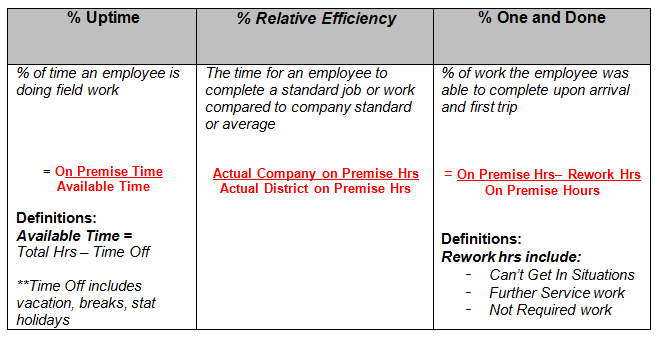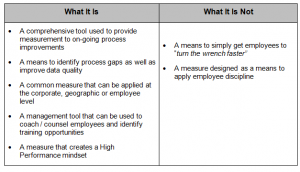December 2011, Vol. 238 No. 12
Features
Utility Thrives With New Employee Effectiveness Measurement System

In today’s ever-changing and increasingly competitive energy industry, utilities continue to search for new ways to achieve operational excellence. As part of its ongoing efforts, Union Gas successfully developed a new measure in 2008 called Overall Employee Effectiveness (OEE).
This measure was developed to help support continuing efforts around process improvements and cost leadership in the Distribution Operations function at Union Gas. In particular, this measure was designed to be a comprehensive measure to support a workforce of nearly 500 employees conducting field pipeline maintenance, standard practice work (i.e., leak surveys, inspections etc.) and meter work across the Union Gas’ franchise in Ontario.
Although the measure was developed around this specific piece of work, it encompasses the entire work cycle from initial planning, to execution, to checking or verification of the work after it is complete.
After developing, testing, and communicating the measure in late 2008, it was implemented in 2009 with company and district targets being set, and results tied to employee incentive programs. Today, OEE has become the principal measure for the utility services fieldwork functions at Union Gas with results reported monthly at the corporate, geographic district, manager and employee level. In addition, process improvement opportunities continue to be identified based on OEE results and new variations of this measure are being developed and implemented for other functions at Union Gas.
Methodology
Overall Employee Effectiveness is designed based on similar measures that are commonly used in a manufacturing environment. OEE combines the components of quality, efficiency, and safety into one comprehensive measure. These three components have always been measured at Union Gas for this work, but never have they been combined into a single measure. The three components used to calculate OEE are:
1) Uptime: The percentage of available time a worker is on a work site completing work. Obviously, the more time that a worker is on a work site the better, so factors such as travel time and meetings have a negative impact on this component.
2) Relative Efficiency: The time for an employee to complete a standard job or work task compared to company standard or average. If a worker completes the work task in less time than the standard, OEE goes up.
3) One and Done: The percentage of work an employee is able to complete correctly during his or her first visit to a work site. Completing work correctly and on the first trip (i.e., no re-works etc.) also has a positive impact on OEE.
Guiding Principles
In establishing and communicating this new measure across the organization, it was important to clearly define and articulate the purpose, guiding principles and what it is/is not to employees at all levels. At Union Gas, we defined the purpose of the OEE measurement as follows:
1) Improve utilization of time by: a) increasing availability of employees, b) improving efficiency of doing fieldwork and c) reducing rework;
2) Improved data quality;
3) Helps create a high performance mindset across the organization;
4) Drives efficiencies;
5) Provides organizational focus: “What gets measured gets done;”
6) Impacts savings and overall earnings;
Union Gas also established the Guiding Principles related to this measure early on in its development in order to steer what was measured and how we will monitor/report on an on-going basis. These guiding principles have and continue to evolve, but are as follows:
1) All productive work that can be measured will be included in the calculation.
2) We will track and report results on a monthly basis.
3) We will continue to monitor and revise the measure and our targets as required to accurately reflect our work effectiveness.
4) We will look for other opportunities/functions in which to apply the OEE measure.
In addition, Union Gas developed a list of “What It Is” and perhaps more importantly, “What it Is Not.” (Table 2).

Implementing OEE
Following the initial development of the measure, a comprehensive communication plan was developed to educate and engage employees from across the company. The communication plan included the following components:
1) Workshops with front-line managers to educate them in how the measure was calculated and how to interpret the results.
2) Videos from senior leaders and other key stakeholders outlining the measure and its alignment with the corporate strategy.
3) Presentations to various employee groups throughout the company, including frontline employees and executives.
4) Monthly posters showing results that were distributed and posted throughout the company for employees to see.
5) Monthly reports that were distributed to a wide audience and showing detailed results on an employee, manager, geographic district and company basis.
In addition to communicating the measure and its results, the company built a thorough change management plan aimed at promoting acceptance, understanding and alignment of this new measure throughout all levels in the organization. The components of this plan included:
1) Employee involvement in the development and refinement of this measure.
2) Employee feedback.
3) Management training on how to use OEE information as part of employee coaching discussions and identification of training needs.
4) Leadership transparency around what the measure is and what it is not.
5) A robust communication strategy to support these plan components.
Results
The OEE measure at Union Gas has proven to be a valuable method to gauge the effectiveness of work processes, identify opportunities for improvement and drive organizational focus. Since OEE was introduced, we have seen a significant improvement in our overall OEE results and the commitment to the processes and procedures it is reporting on.
In the area of conclusions and recommendations, let us quickly look at critical success factors and potential pitfalls. Through the development, refinement and implementation of this measure, many things were learned. One of the key lessons learned was that an Overall Employee Effectiveness measure, while typically applied in manufacturing sectors, is a new measure in the utility industry.
During the project term, members of the Project Team and Senior Leaders spoke with numerous industry contacts about OEE and learned that Union Gas is a leader in developing and utilizing this type of comprehensive measure. We are aware of only one other utility company worldwide with such a metric. Many companies track productivity. However, this creative measure drives accountability and measurement to a new level.
Since the creation and introduction of the OEE measure at the company, some critical success factors or potential pitfalls have become apparent. These are: 1) active executive leadership and involvement; 2) open and honest communication about expectations at all levels; 3) tied to rewards/benefits; 4) employee engagement and involvement (alignment with strategic intent: operational excellence, safety etc.); 5) the need for good data (systems such as Advantex, employee accountability); 6) continued focus and effort related to communications and change management to gain organizational acceptance; and 7) willingness to accept input and revise approach.
Recommendations
The use of a measure such as OEE in a utility setting is somewhat unconventional, but the results have proven to be encouraging and rewarding from many different perspectives. The creation of the measure itself and the related data mining that goes along with it is really just the starting point to ensuring success.
Executive leadership, alignment with strategic intent and strong communications and employee engagement will provide the foundation for long-term, sustainable success.
Acknowledgement
This article is based on a manuscript by the author that preceded the preparation of his presentation for the American Gas Association Operations Conference & Biennial Exhibition, May 2011, in Nashville, TN.
Author
Jeff Hodgins is manager of distribution operations support for Union Gas Ltd., London, Ontario. His role leads numerous support activities for the distribution operations function at Union Gas. He joined the company in 1993 and has held a variety of positions in marketing, sales, business development and operations. During 2008-2010, he led a corporate initiative aimed at improving the overall effectiveness of the utility’s field work. The project included contributions from numerous employees across the organization and resulted in the development and implementation of the Overall Employee Effectiveness measure. He is a graduate of the University of Windsor with a bachelor of commerce degree with honors and a master’s degree in business administration. He can be reached at: jhodgins @uniongas.com.
Impacts Of The Overall Employee Effectiveness Measure At Union Gas
Business Impacts
1) Results: Since its introduction in 2009, the OEE Results at Union Gas have continued to improve. These improvements translate into productivity and dollar savings and will help position Union Gas for the future.
2) On-Going High Performance: The numerous process improvements implemented or identified as an outcome of this work and the technology enhancements used to support OEE provide a foundation upon which to build.
3) Common Measure and Focus: Historically, the company has reported on the three components of OEE (safety, quality and efficiency) as separate or unique measures. The OEE measures bring all three components together and helps drive alignment and focus at all levels of the organization.
4) Future Applications/Other Opportunities: The OEE measure as originally developed was designed for the front line maintenance work. Since its introduction, other OEE type measures for different functions in the organization are also being developed.
Employee Impacts
1) Individual Accountability (Clear Measures and Expectations): The development of the Overall Employee Effectiveness measure enables frontline managers to have more effective productivity discussions with their direct reports. This also results in an enhanced relationship and increased business understanding on the part of both the manager and the employee. The OEE measure is now the standard productivity measure used across the Distribution Operations function at Union Gas and will allow increased ownership for individual employee and team performance. Clarified accountabilities for work processes has reduced cycle time, optimized processes and highlighted best practices in one area so that they can be leveraged across the organization.
2) Leadership (More Effective Leaders): The coaching and culture change workshops conducted as part of this project have provided frontline managers with the skills to have high quality discussions with their employees regarding safety and effectiveness. These discussions will lead to further productivity improvements and identification of training opportunities for our entire workforce.
3) Workforce Satisfaction: the process improvements identified and implemented do not only provide direct benefits but also indirect benefits, such as a more satisfied workforce. Most employees want and enjoy smooth and efficient processes and removing barriers creates a more satisfied and productive workforce.





Comments